The day was predicted to be cloudy and windy. Cloudy is good for a wildflower photographer; windy is not. I had contacted one of my flickr friends, Will Stuart, to see if he was willing to join me at one of the most interesting granite outcrops in the Southeast. The name of the place is Forty Acre Rock Heritage Preserve. It consists of about 2300 acres of land which includes a 14-acre, granite outcrop. This outcrop hosts several endangered/threatened species. Will has been to the site on many occasions, but I had never had the opportunity to visit.
We decided to meet just outside this Lancaster County, South Carolina, preserve about 9:30 am. That meant that I had to leave home at 6:30 am, since it is about a three-hour drive for me. Will lives only 1.5 hours away from Forty Acre Rock, which is why he has made many visits to the location. As I neared the rendezvous, I saw a sign that told me I was very close:
BTW, the spots on the lower left side of the sign are holes left from shot gun pellets. Shooting signs (and mailboxes) seems to be a normal pasttime in rural South Carolina.
I was a bit early, so I waited for the meeting. When Will drove up, we exchanged pleasantries, and I followed him in my vehicle about five miles to a parking area in the woods. We quickly loaded our camera gear and headed off down a half-mile sandy trail. As we got close, I could see the beginnings of the granite outcrop and a large opening in the woods.
This is a really big “bald” rock. This shot covers only a small view of the open area, surrounded by woods:
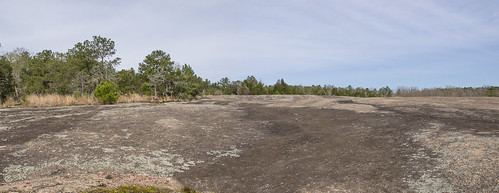
As you can see below, the surface of the outcrop is pocked with rounded depressions, some being fifteen or twenty feet (5 to 7 meters) in diameter, but most being three to six feet (1 to 2 meters) in diameter.
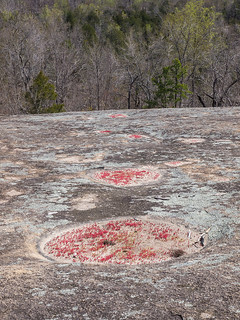 |
 |
These depressions hold water during the spring season, and this water does not usually last much into the summer (they are known as vernal or ephemeral pools). Since the water doesn’t hang around very long, the plants that inhabit these pools must get their business done in a hurry before the pools dry up.
This type of habitat is quite rare in the Southeast. We have a number of large granite outcrops, but very few of them have just the right components to host rare plants. The three species I was hoping to photograph are Diamorpha smallii known as Elf orpine, Sedum pusillum known as Puck’s orpine, and the uber-rare Amphianthus pusillus (recently renamed as Gratiola amphiantha), both known as Pool Sprite or Snorklewort. How is THAT for a wonderful common name?
First, let me describe Elf orpine. The plants are about one to two inches (2.5 cm to 5 cm) tall and have bright red, succulent or fleshy leaves. The four-petaled, white flowers are born in a terminal cyme. The operative words here are “bright red”. That is the first thing I noticed when I came upon the first of several sand-filled depressions:
 |
 |
Note that in the image on the left, the color appears to be uniformly red, while in the image on the right, the color appears to be red and white. That is because the former depression holds plants that were just in bud, while the latter depression holds plants in full bloom. Go figure… One would expect that all of the plants would bloom more or less at the same time. Will Stuart postulates that the water content of the depression affects the blooming — when the depression begins to dry out, the flowers open. I don’t know if that is true, but it makes more sense than anything I could come up with.
Closer inspection of the flowering plants, shows the incredible beauty of the bright red, fleshy leaves and the pure white flowers:
 |
 |
 |
 |
After a diligent search, I was able to find a couple of plants which were separated from the group. I wanted to be able to show the entire plant. Both of these plants are quite similar in size and shape, but they are indeed two separate plants:
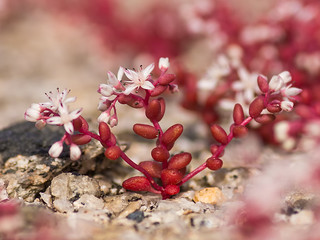 |
 |
The second of the three rare species at the site is Sedum pusillum or Puck’s orpine. I did not make up these common names. I don’t know who Puck was, but that’s a wonderful, common name. This plant is so similar to Elf orpine, that it takes some study to be able to tell them apart. First, Puck’s orpine does not inhabit the epemeral pools. It rather likes the shady edges of the granite outcrop, usually under Juniperus virginiana known as eastern red cedar. When it grows in a really shady environment, the leaves are green. When the habitat gets a moderate amount of sun light, the leaves are more red than green, but not nearly as bright red as the leaves of Elf orpine:
 |
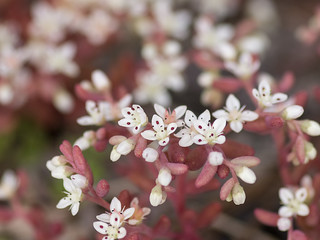 |
To show the size of these dimutive plants, I have included a penny for scale:
 |
 |
Another difference between Puck’s orpine and Elf orpine is found in the flower petals. To me, the petals of Puck’s orpine appear to be more rounded than those of Elf orpine. In addition, I noticed several flowers of Puck’s orpine that had five petals. I did not notice this with Elf orpine (see five-petaled flowers in above two shots).
The third species I had hoped to find in bloom is the very rare Amphianthus pusillus or Gratiola amphiantha also known as Pool Sprite or Snorklewort. I know, this is very confusing. The reason for showing two botanical names is that Amphianthus pusillus was reclassified as Gratiola amphiantha in 2008, but it is still known by the former name in many texts. Change is hard… but I digress.
This plant is very small, and curiously enough, often it is the only inhabitant of a particular ephemeral pool. Its flowers are only about 1 mm to 2mm wide when they are fully open. On this day, I found plants with a number of unopened buds. I don’t know if that was due to a very cool morning, strong winds, or less than full sunlight. In any case, I will have to come back another time to see fully open flowers:
 |
 |
The tiny yellow specs you can see on the leaves and in the water is tree pollen — probably pine tree pollen. The half-inch (1 cm) leaves in the above shots are floating in about two inches (5 cm) of water. At this point, it is a good time to mention that Pool Sprite has a set of basal leaves that are quite different from the floating leaves:

These basal leaves remain attached to the sand in the bottom of the pools and anchor the floating leaves which bear the flowers.
There are several other interesting wildflower species found at Forty Acre Rock. None of them are particularly rare, but they are especially attractive. There are two bright yellow flowering species, Packera tomentosa known as Wooly Ragwort, and Gelsemium sempervirens known as Yellow Jessamine and Carolina Yellow Jasmine. (Note the difference in the spelling of Jessamine/Jasmine).
 |
 |
Incidentally, Yellow Jessamine is the state flower for South Carolina.
Another wildflower that is found at Forty Acre Rock as well as in the mountains is Erythronium umbilicatum also known as Trout Lily. This species is different from a similar species, Erythronium americanum in one easily seen respect: The seed capsule is indented on the apex, and bends to rest on the ground as it matures. The seed capsule of Erythronium americanum is rounded on the apex and remains upright as it matures.
 |
 |
There is one wildflower that not only appears in the ephemeral pools along with Elf orpine, but also along the edges of the granite outcrop with Puck’s orpine. That wildflower is Minuartia uniflora or Piedmont sandwort.
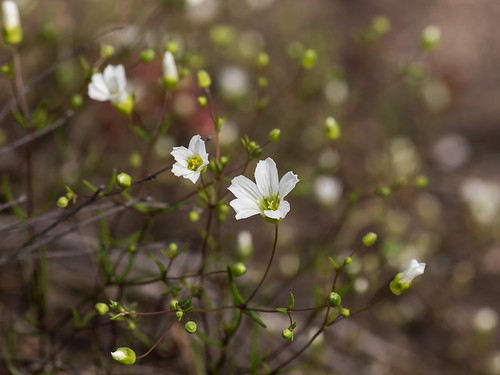
During our visit, the flowers of Piedmont sandwort were in full bloom along the edges of the granite outcrop, but were not yet fully open when associated with Elf orpine. That’s too bad, because the combination of both of these wildflowers, when in full bloom, is rather spectacular. Maybe next trip…
There are other pools, some quite large, that are habitats for several of the rare species as well as a number of Quillwort Isoetes species:

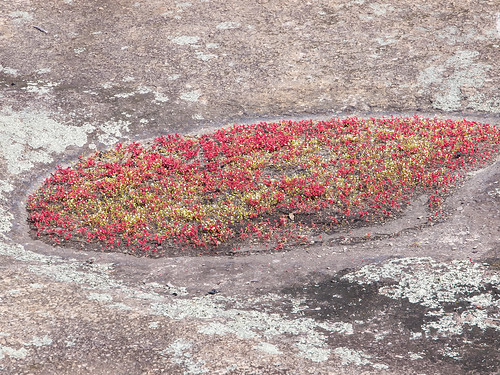
Finally, here is a shot of Will, up close and personal with a pool containing Elf orpine in full bloom:

What a great day we had! Except for the relentless cold wind, I couldn’t have wished for a better show of rare wildflowers.
— Jim

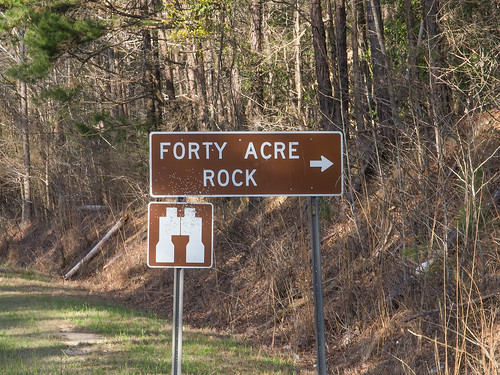
0 Responses
These are exquisite! Thanks for sharing your love of the natural world in this way. So glad to get your blog.
Jim, so much new here for me to study. I love learning about new environments. All of these plants are marvelous and special. Thanks.
I’ve never heard the term vernal (or ephermal) pool before — always good to learn something new. It’s amazing that even though these pools dry out each summer they can still support such an abundance of life.
And I adore the name snorklewort!
I came across your blog looking for more information on Elf orpine and Gratiola amphiantha – interesting plants I stumbled across about a month ago in a granite outcrop hidden among the woods in Georgia. Thank you for wonderful pictures and the wealth of information you shared.